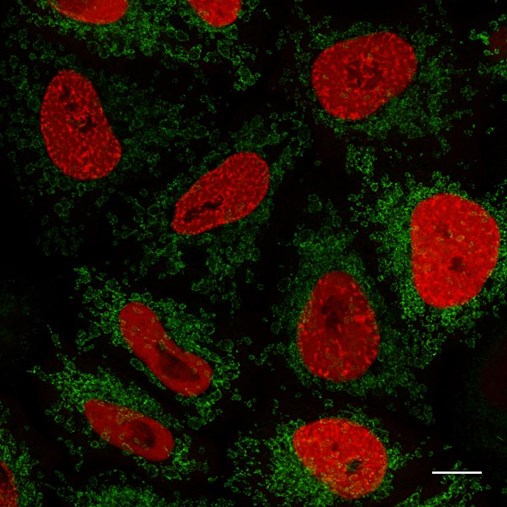Conjugation of fluorescent dyes to Nanobodies
The conjugation of the binding domains of camelid heavy chain antibodies, also known as VHHs or Nanobodies, to fluorescent dyes is generating versatile tools for fluorescence microscopy applications like immunofluorescence (IF) and super resolution microscopy (SRM):
The conjugation of the binding domains of camelid heavy-chain antibodies, also known as VHHs or Nanobodies, to fluorescent dyes is generating versatile tools for fluorescence microscopy applications like immunofluorescence (IF) and super-resolution microscopy (SRM): The small size Nanobodies provide better penetration into tissue and dense cell compartments, plus the small label to epitope displacement provides higher resolution. In addition, the Nanobodies’ high-affinity binding to epitope makes them attractive probes for other assays like ELISA.
ChromoTek, part of Proteintech Group, provides multiple fluorescent dye (Alexa Fluor® and ATTO) conjugated Nanobodies that are optimized by application:
Nano-Boosters bind to Green and Red Fluorescent proteins (GFP and RFP) and retain and enhance (“boost”) their signals. Nano-Labels are used for staining of non-fluorescent peptide tag or endogenous proteins like the Spot-Tag, histone, and vimentin. Nano-Secondaries bind to primary mouse, rabbit, and human antibodies in a species and subclass specific manner. Though ChromoTek offers a comprehensive set of fluorophores, customers may want to use Nanobodies conjugated to alternative fluorophores that are not available in our catalog. In order to assist, find below labeling protocols for ChromoTek Nanobodies sorted by labeling chemistry, i.e., NHS and maleimide conjugation.
Comparison of labeling chemistries
When planning the conjugation, please consider (i) that the labeling chemistry for conjugation depends on the Nanobody and (ii) the implications of using different labeling chemistries.
Nanobodies with free cysteine(s) (not canonical cysteines!) can be conjugated with maleimide derivatives of dyes, whereas Nanobodies without cysteine(s) can be labeled via NHS derivatives of dyes. Some of ChromoTek’s Nanobodies have sortase tags and can be labeled enzymatically using sortase and corresponding peptide derivatives of dyes.
 |
||
| Immunostaining with GFP-Booster Alexa Fluor® 488 (green) and RFP-Booster Alexa Fluor® 568 (red). HeLa cells were transiently transfected with Tom70-eGFP and PCNA-mRFP. Scale bar, 10 µm. Images were recorded at the Core Facility Bioimaging at the Biomedical Center, LMU Munich. |
The conjugation of dyes to cysteine residues provides site-directed labeling with defined degree of labeling (DOL). Conjugated Nanobodies are suitable for quantitation assays. The DOL depends on the quantity of accessible cysteine residues; generally, our Nanobodies have 1 or 2 cysteines.
The conjugation of fluorophores to lysine residues is a rather random labeling and the DOL depends on the equivalents (molar ratio) of dye used. It is recommended to aim for a DOL 1-2 to keep the conjugated Nanobody stable and soluble. This DOL generally works for quantification assays, too. ChromoTek’s Nanobodies without free cysteines are buffered in TAPS, hence they are ready to use. However, the removal of the preservative is recommended.
Finally, the enzymatic conjugation with e.g. sortase requires a sortase tag on both the C- or N-terminus of the Nanobody and on the dye (=fluorophore labeled peptide). The enzymatic labeling is a steady state reaction and you may want to push the reaction towards the products for effective labeling.
Related Content
Why are recombinant Nanobodies/ VHHs beneficial?
GFP Nanobody for better images in immunofluorescence
GFP and RFP-Booster for better immunofluorescence imaging
Want to upgrade your immunofluorescence workflow? Go Direct!
New anti-mNeonGreen antibody & Nano-Trap for Immunofluorescence & Immunoprecipitation
Advantages of recombinant Nano-Secondaries
Important facts to know when using Nano-Secondaries
Actin Chromobody for live-cell super-resolution imaging

Support
Newsletter Signup
Stay up-to-date with our latest news and events. New to Proteintech? Get 10% off your first order when you sign up.